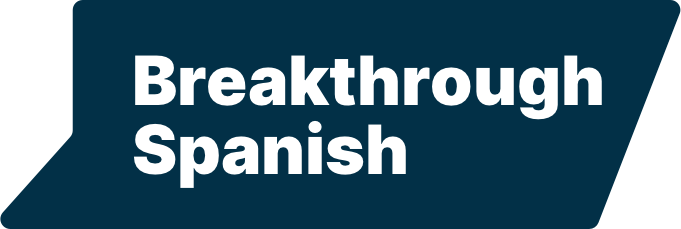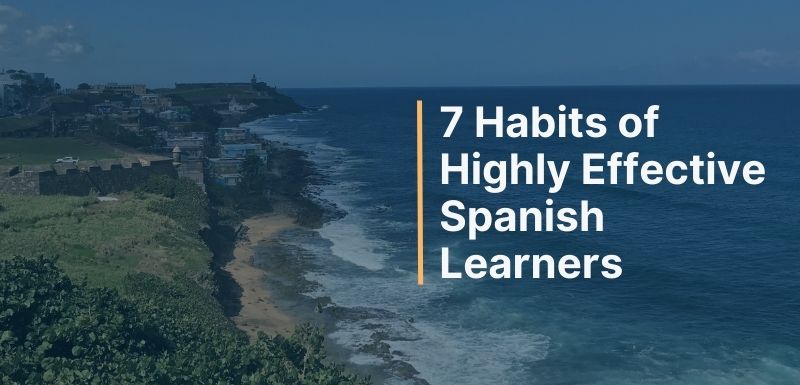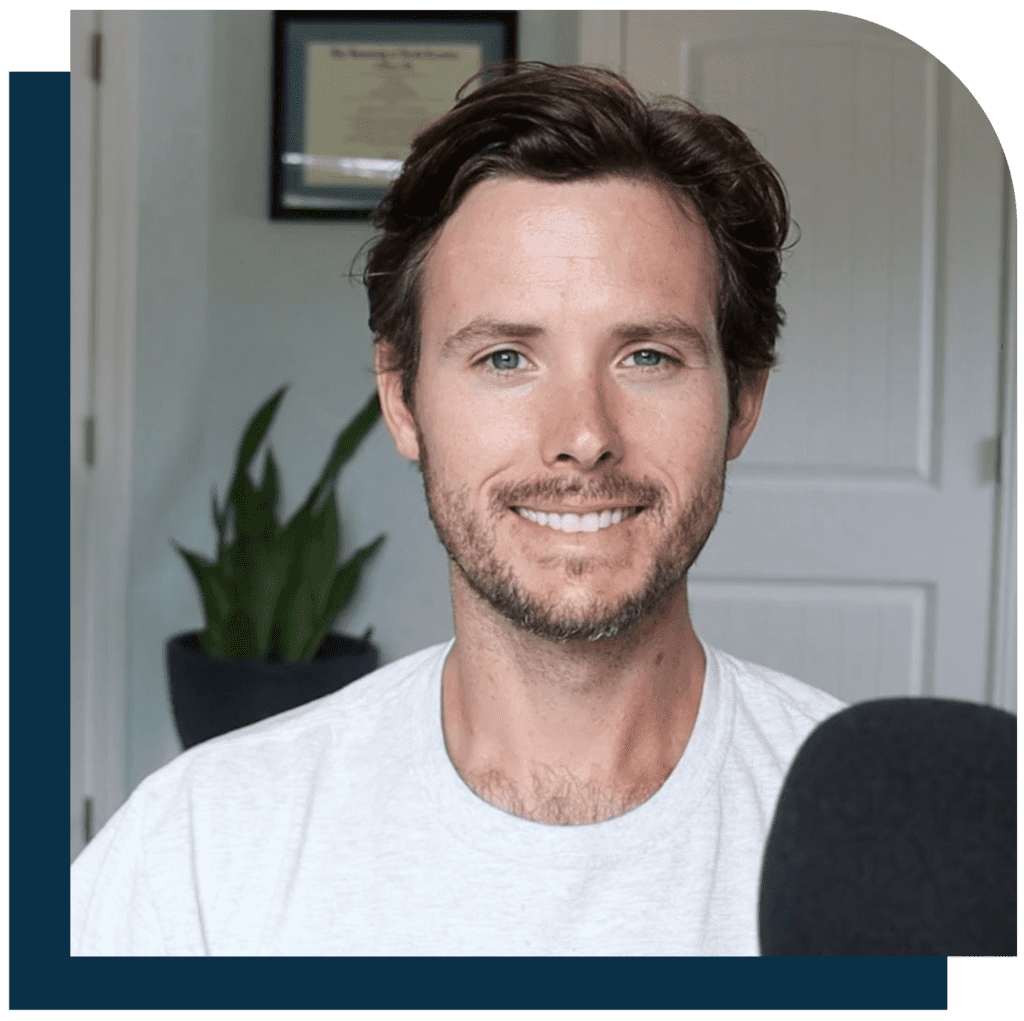Some people learn Spanish faster and more effectively than others.
Why is that? What makes someone an effective Spanish learner?
In my experience, it’s nothing too hard — it boils down to their habits.
Here’s something I say often:
Learning Spanish has less to do with how smart you are, and more to do with how consistently and effectively you learn.
So what habits make for an effective Spanish learner? Which habits can you adopt to improve your Spanish in less time?
Here are 7 Spanish learning habits that I coach people to use so they can learn more effectively:
- 1. Set aside the same time each day
- 2. Start small enough that you can do it every day
- 3. Focus when you’re supposed to be focusing
- 4. Use a limited number of learning materials
- 5. Use the Pareto Principle to learn vocab and grammar
- 6. Learn words that are useful to you
- 7. Speak often
- These Spanish learning habits & routines will help you learn more effectively:
- What now?
1. Set aside the same time each day
Building a habit — any habit — becomes easier when we know when to do the thing.
You know that you’re supposed to brush your teeth before you go to bed — going to bed is the cue.
You know that when you wake up, you walk to the kitchen and start making coffee.
If you know when you’re supposed to learn Spanish, it’s much easier to make it a regular habit.
An average Spanish learner might say, “I’m going to try to learn for 30 minutes a day”.
A highly effective Spanish learner would say, “Every morning after I let the dog out, I’m going to open my Spanish lesson and listen for one minute.”
Why not “listen for 30 minutes”? That brings us to Habit #2:
2. Start small enough that you can do it every day
It’s not easy to form new habits. I’m sure you’ve experienced this.
Maybe you had a goal to run every day, or to do your homework each night instead of at the last minute. Whatever it was, it didn’t stick. One reason it didn’t stick is because you probably tried to do too much at once.
In Atomic Habits, James Clear writes about how an aspiring runner shouldn’t set a goal of running a mile a day. Instead, they should put their running shoes next to their bed and say, “each morning, I’m going to put my running shoes on.” Once the shoes are on, it’s hard not to at least step outside.
Learning Spanish is similar: the hardest part is getting started each day.
If all you need to do is open your app, or read one page in your book, or say one sentence out loud, or answer one question — it’s so easy you can’t not do it.
Once you begin, most of the time you will keep going for longer. All you needed was the momentum to start.
On the flipside, some of you might be excellent habit-formers.
Too good, in fact! You might jump into Spanish doing 2 hours a day from day one.
In most cases, this is not sustainable. It’s similar to nutrition: you wanted to start eating healthier, and started only eating broccoli, almonds and chicken breast 3 meals a day, you might burn out and give up. A more sustainable approach (and thus more effective in the long run) would be to slowly replace things in your existing diet with healthier options.
Approach Spanish in a similar way: slowly start replacing activities, one at a time, with activities in Spanish.
Here’s the key: at the beginning, do less than you think you can do. Leave yourself wanting more Spanish. That will keep you coming back each day. Over a week or two, you’ll build up to a Spanish learning routine that takes 30 minutes or even an hour a day.

3. Focus when you’re supposed to be focusing
Not all Spanish learning needs to be 100% focused. Sometimes, you might be listening to Spanish while you do the dishes or go for a run, or reviewing things in the living room while your partner watches TV.
But the core of your Spanish learning — your 20, 30, 40 minutes a day — needs to be laser-focused.
This is where deep learning happens. This is where you challenge yourself, create your first spoken sentences, and make sense of tough sentences.
Without this focused Spanish time, your learning will take much longer. When your attention is divided, neither your short nor long term memory work as well.
4. Use a limited number of learning materials
Distraction (too many learning materials) is the enemy of progress. Spanish is a language that many want to learn — meaning we’re blessed with lots of great materials.
So many materials, in fact, that it becomes extremely difficult not to bounce all over the place. You can easily spend more time looking up new resources and trying new free trials that actually learning Spanish.
Often, trying different resources is just a distraction — we do it to avoid the hard work of focused learning. I know that’s true for me.
So if you’re using Duolingo, Anki, a notebook, 2 grammar books, Coffee Break Spanish, News in Slow Spanish, and reading Garfield in Spanish… reel it in! Cut out half of those items.
All you need are a core resource (the one you’re using each day for focused learning), a way to acquire vocabulary like Anki or a notebook, and a way to practice speaking.
5. Use the Pareto Principle to learn vocab and grammar
Not all words or grammar are created equal.
Many words and grammar structures are significantly more common (and therefore useful) than others.
You might already be familiar with the Pareto Principle — the concept that in many fields, 80% of results come from 20% of effort.
This is certainly true for Spanish.
In fact, the 1000 most common Spanish words give you access to roughly 88% of spoken Spanish.
An important caveat: the difference between understanding 88% and 95% is actually huge, because that difference is made up of many useful words.
But still — once you do know the most common words, the rest becomes a bit easier.
[Related: Is it hard to learn Spanish? 3 key factors to know]
Same thing goes for grammar. Certain grammar structures are very helpful to communication — things like personal pronouns, forming negative sentences, comparisons, simple present and past conjugations, etc. Many other things are less crucial. You can learn them as you go.
6. Learn words that are useful to you
As an addendum to the Pareto Principle above, I’d like to add a subset of things that are worth learning: words and phrases that are relevant and useful to your specific life.
If you’re a photographer, it’s going to make sense to learn phrases that include words like shutter speed, aperture, and lens.
If you love whale watching, you’ll find interest, joy, and motivation in learning how to talk about ballenas jorobadas, azules, and cachalotes.
If you have grandchildren, you’ll want to be able to discuss your nietos y nietas, their ages, grades, and things they like to do.
When you learn these phrases, you’ll have an easier time remembering them because the motivation is built in.

7. Speak often
Speaking is how we turn Spanish from something we know intellectually into something we can use to communicate.
Each time you speak, you consolidate everything you’ve learned up to that point. You’re pulling from everything you’ve learned about sentence structure and vocabulary.
Learning to speak Spanish is a process of learning a little bit of theory, then quickly putting it into practice, then repeating. If you’ve never strung a sentence together, it won’t matter that you know 5000 words — you’ll be just as tongue tied as if you knew 50 words.
Speaking can mean speaking with others, but it doesn’t have to.
In fact, on a daily basis, one of the best things you can do is speak to yourself.
You can create sentences from new words you’ve learned, find questions in Spanish and answer them out loud, or simply give yourself a topic to discuss alone while you’re driving to the grocery store.
These Spanish learning habits & routines will help you learn more effectively:
Let’s quickly summarize the 7 habits above.
- Set aside the same time each day to learn
- Start small enough that you can stick with it
- Focus when you’re supposed to be focusing
- Use a limited number of learning materials
- Use the Pareto Principle (80/20 rule) to learn grammar and vocabulary
- Learn words that are useful to you
- Speak often
What now?
You’ve read, now it’s time to take action. Choose one of these 7 habits to try out today. I recommend starting with #1. If you don’t already have a consistent time of day when you always learn Spanish, start there. Maybe it’s a window of just 10 minutes after lunch — whatever you know you can do consistently. Over the next week, focus just on doing one thing with Spanish during the time you set aside.
If you already have a consistent habit and routine, pick something from #3-7 to focus on this week.
Put these in place and you will start making much faster progress in your Spanish.
Let me know in the comments if you have any questions.
Want me to help you create a Spanish learning habit that sticks? Click here to learn more about the 6 week Breakthrough Spanish Challenge.


